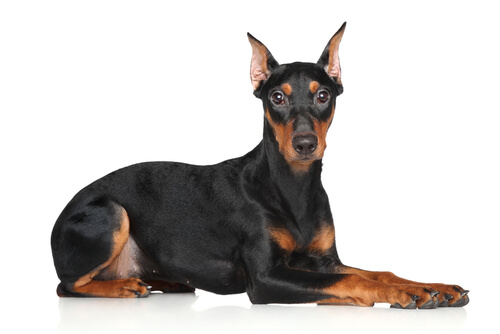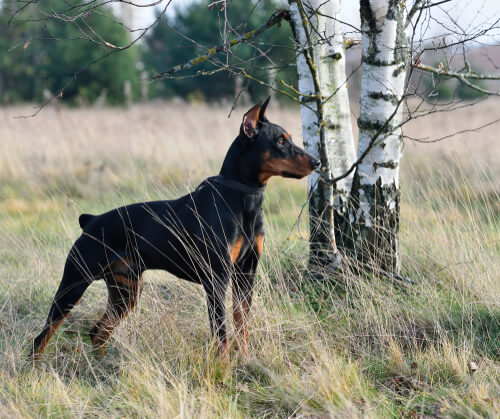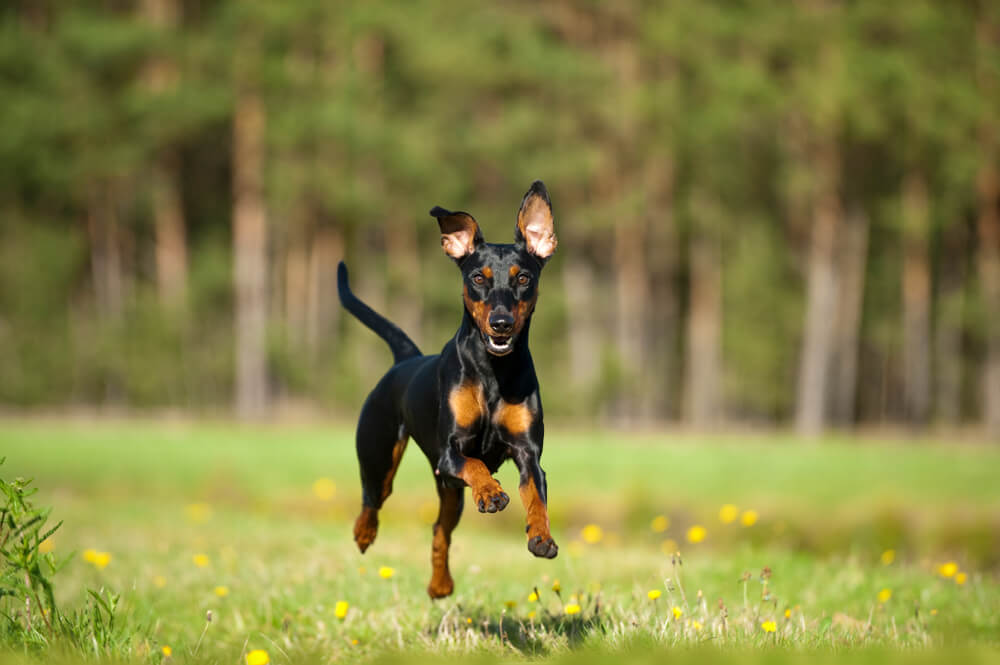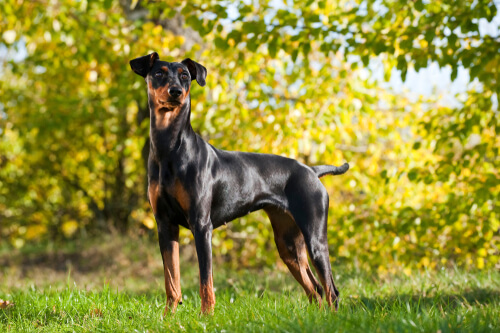
| Kingdom | Animalia |
| Phylum | Chordata |
| Class | Mammalia |
| Order | Carnivora |
| Family | Canidae |
| Genus | Canis |
| Species | C. lupus |
| Species | C. lupus familiaris |
| Niche | Domestic |
| Height | 17-20 inches (43-51 cm) |
| Weight | 25-45 lbs (11-20 kg) |
| Lifespan | 12-14 years |
| Social Structure | Social, domesticated |
| Breed Status | Common, (134th of 196 – American Kennel Club) |
| Preferred Habitat | Domestic |
| Average Litter Size | 6-8 puppies |
| Main Food Item | Dog Food |
The Basics
The German Pinscher is a medium-sized breed of domestic dog. Members of the breed are usually mostly black with a long, streamlined body. They are often used as guard dogs and are common pets and show dogs as well.
German pinschers look much like the Doberman Pinscher but smaller, or the miniature pinscher but larger. In fact, it was likely the foundational breed for the other two. They are strong and muscular, weighing 25-45 lbs (11-20 kg) and standing 17-20 inches (43-51 cm) tall at their withers. Their coats are shiny and smooth and are most commonly black with tan feet and facial markings. However, additional coat colors exist such as red, ‘fawn’, or blue with tan or red markings. Before the World Wars, there were additional color morphs such as the pure black and ‘salt-and-pepper’ variety that have since gone extinct. Historically, most members of the breed had docked tails and cropped ears for both appearances and largely invalid health concerns. Today, this practice continues where legal, largely for cosmetic reasons.

German pinschers were developed in the late 1700s in Germany as a working and hunting dog, used to kill vermin. The German Pinscher, which itself became the foundation for many other dog breeds, was likely developed from the now extinct Rat Pinscher. It became formally recognized as a breed in 1895 but like many breeds declined in popularity during the World Wars, nearly going extinct.
After WWII, efforts to revive the breed by a West German named Werner Jung were successful and the breed made its way to the United States in the 1970s. In 2003, the breed was formally recognized by the American Kennel Club. Currently, the breed ranks 134th in popularity among the breeds recognized by the AKC
Temperament/As Pets
German Pinschers are excellent guard dogs and affectionate family dogs. They are alert and playful and known for being good-natured if not independent at times. They are highly adaptable and intelligent, but due to their large size and high energy levels, they are best suited to a home with a yard for them to run in. German Pinschers are very social and wish to be involved in everything that their family is doing.

Due to their history of being used as a dog to hunt rodents, they are not typically well-suited to homes with other small pets such as guinea pigs. They can be assertive and overbearing and thus are not an excellent choice for new or timid dog owners. Their protective streak and tendency to chase smaller animals means that they require firm, early, and consistent training and socialization to get the best out of them as pets.
Females will typically give birth to litters of 6-8 puppies. Despite some health issues with the breed due to a reduced gene pool, German Pinschers are relatively long-lived. Most individuals will live for 12-14 years.
Fun Facts about German Pinscher!
Despite not making their way to the United States until relatively recently, German Pinschers are now a familiar breed, along with their larger Doberman and smaller Minature cousins. They are now common pets, show dogs, and are even used as therapy and service dogs due to their high levels of loyalty and intelligence.
A Softer Side
Although pinschers are often associated with snarling guard dogs, they are excellent family pets and companions as well. Furthermore, they have been successful in other areas as well such as conformation shows and agility and speed competitions. Pinschers are also used as therapy dogs. Their intelligence and trainability make them excellent for this purpose. Therapy dogs may be used as emotional support for patients in recovery from an illness or suffering from mental health challenges.

Strength and Grace
Despite their effectiveness as guard dogs and fierce loyalty to their owners, German Pinschers are also known for their elegance and grace. They have long, thin legs and a lean body. Often they are seen with pointed ears due to cropping practices where this is legal, adding further to their strong and pointed features.
Son of a Schnauzer
The Standard Schnauzer is a modern dog breed dating back to the 1400s in Germany. It was formerly referred to as the “Wire-Haired Pinscher” and was often born in the same litters as the now German Pinscher. Eventually, breeders would end up separating these varieties, leading to them becoming very distinct breeds. Despite their distinct appearances now, their common lineage is apparent in their shared behaviors. Both breeds are instinctively keen to hunt small vermin and, as pets, become very excited over the prospect of getting to chase small animals like squirrels around the forest in futility.
